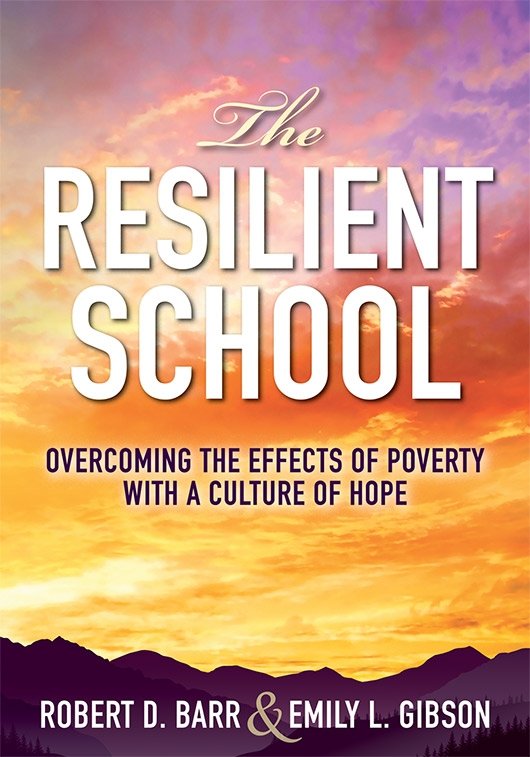Free Reproducibles
Building the Resilient School
Discover how to use resiliency and hope to address student needs and overcome the effects of poverty in the 21st century. Build learners’ emotional intelligence and self-regulation skills so they can face adversity and defeat learned helplessness.
Benefits
- Learn how to select data-collection strategies that will yield the most useful data.
- Determine how well a program is aligned with standards and meeting learning goals.
- Gain strategies to understand a program or instructional strategy’s strengths, and identify ways to address its weaknesses.
- Explore how to include a variety of stakeholders in the program evaluation process, ensuring transparency and collaboration throughout.
TABLE OF CONTENTS
Introduction: Poverty—Our Greatest Challenge
Part One: Understanding Poverty
Chapter 1: Poverty—On the Outskirts of Hope
Chapter 2: An Invisible Barrier—The Impacts of Poverty on Teaching and Learning
Chapter 3: An Unanticipated Challenge—The Detrimental Impacts of Poverty on School Staff
Part Two: Introducing the Resilient School
Chapter 4: The Research—Studying Resilient Students and Resilient Schools
Chapter 5: The First Cornerstone of the Resilient School—Addressing Students’ Academic Needs
Chapter 6: The Second Cornerstone of the Resilient School—Addressing Students’ Social-Emotional Needs
Chapter 7: The Third Cornerstone of the Resilient School—Addressing Students’ and Their Families’ Human Needs
Chapter 8: The Fourth Cornerstone of the Resilient School—Addressing Staff’s Relational and Professional Needs
Epilogue: A Personal Note and a Vision for Resilient Schools
Appendix
STUDY GUIDE
PRINTABLE REPRODUCIBLES
Chapter 1
Chapter 2
Chapter 3
Chapter 4
- Figure 4.1: Internal Protective Factors of Resilience
- Figure 4.2: External or Environmental Protective Factors of Resilience
- Next Steps
Chapter 5
Chapter 6
Chapter 7
Chapter 8
Appendix
SUGGESTED RESOURCES
BOOKS
- Barr, R. D., & Gibson, E. L. (2013). Building a Culture of Hope: Enriching Schools With Optimism and Opportunity. Bloomington, IN: Solution Tree Press.
- Barr, R. D., & Parrett, W. H. (2007). The Kids Left Behind: Catching Up the Underachieving Children of Poverty. Bloomington, IN: Solution Tree Press.
- Brendtro, L. K., Brokenleg, M., & Van Bockern, S. (2019). Reclaiming Youth at Risk: Futures of Promise (3rd ed.). Bloomington, IN: Solution Tree Press.
- Buffum, A., Mattos, M., & Malone, J. (2018). Taking Action: A Handbook for RTI at Work. Bloomington, IN: Solution Tree Press.
- DuFour, R., DuFour, R., Eaker, R., & Karhanek, G. (2010). Raising the Bar and Closing the Gap: Whatever It Takes. Bloomington, IN: Solution Tree Press.
- DuFour, R., DuFour, R., Eaker, R., Many, T., & Mattos, M. (2016). Learning by Doing: A Handbook for Professional Learning Communities at Work (3rd ed.). Bloomington, IN: Solution Tree Press.
- DuFour, R., & Marzano, R. J. (2011). Leaders of Learning: How District, School, and Classroom Leaders Improve Student Achievement. Bloomington, IN: Solution Tree Press.
- Jensen, E. (2019). Poor Students, Rich Teaching: Seven High-Impact Mindsets for Students From Poverty (Rev. ed.). Bloomington, IN: Solution Tree Press.
- Larson, M. R., & Kanold, T. D. (2016). Balancing the Equation: A Guide to School Mathematics for Educators and Parents. Bloomington, IN: Solution Tree Press.
- Lezotte, L. W., & Snyder, K. M. (2011). What Effective Schools Do: Re-Envisioning the Correlates. Bloomington, IN: Solution Tree Press.
- Tileston, D. W., & Darling, S. K. (2008). Why Culture Counts: Teaching Children of Poverty. Bloomington, IN: Solution Tree Press.
WEBSITES
Chapter 2
- Adverse Childhood Experiences (ACEs)
- Trauma and Learning Policy Initiative
- Trauma and Learning Policy Initiative, “Helping Traumatized Children Learn”
- ACEs Too High, “Got Your ACE Score?”
Chapter 3
Chapter 4
- Search Institute, “The Developmental Assets Framework”
- The Education Trust
- Trauma and Learning Policy Initiative
- ACEs Too High
- ASCD, “Whole Child” approach
Chapter 5
- AVID
- Center on Response to Intervention, “Essential Components of RTI” More information on interventions and remediation
- Facing History and Ourselves, “Socratic Seminar”
- Positive Behavioral Interventions and Supports (PBIS) Self-regulation strategies
Chapter 6
-
Collaborative Problem Solving (CPS)
Social-emotional learning opportunities
- PeaceJam
- Solution Tree, “Building a Culture of Hope” free reproducibles
Chapter 7
- LEAP Academy
- Multnomah County, SUN Service System
- The Centergy Project Community partners
- Coalition for Community Schools
- National Center for Community Schools
- Coalition for Community Schools, “Indicators of Capacity”
- The Coalition for Community Schools’ Partnership Compliance Checklist
- Coalition for Community Schools, “Community Schools Leaders Network”
- Coalition for Community Schools, “Community Schools Coordinators Network”
- Search Institute, “The Developmental Assets Framework”
- Search Institute, “The Developmental Relationships Framework”
- TRACEs Central Oregon in partnership with Oregon State University–Cascades, “Measuring Strengths to Nurture Resilience in Central Oregon”
- The Trauma Responsive Schools Implementation Assessment (TRS-IA)
Chapter 8
- Saakvitne & Pearlman’s Self-Care Assessment Worksheet
- AllThingsPLC
- Learning Forward, “ESSA Includes Improved Definition of Professional Development” Surveys for staff and student engagement
Epilogue

